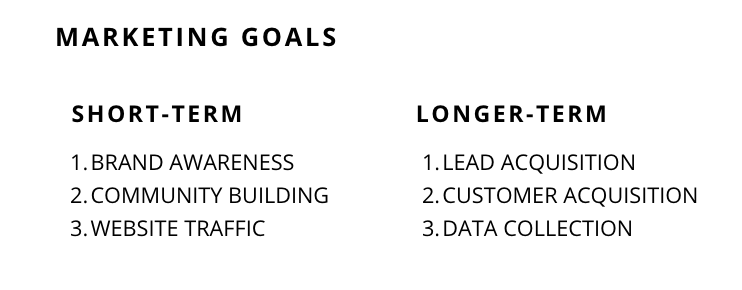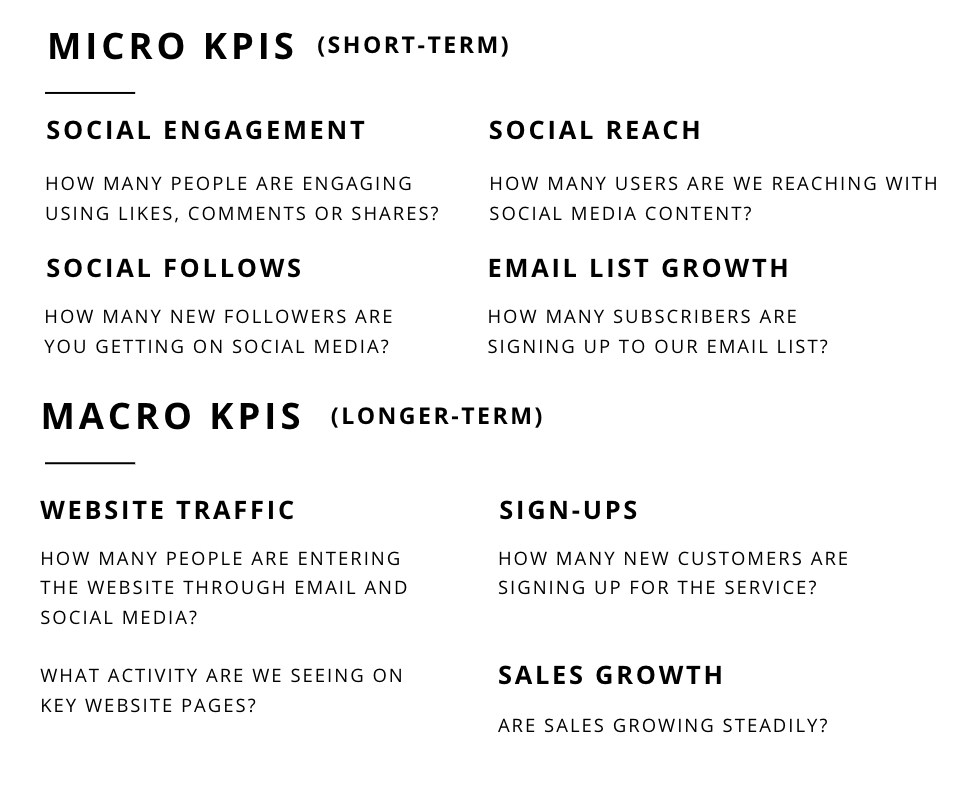When we start working with a new client, one of the first things we do is set short and long-term marketing goals.
Your business goals determine the shape that your marketing strategy takes. A goal of increasing brand awareness, for example, will require different tactics than the goal of attracting new leads or driving repeat purchases.
Realistically, most businesses have a few different business goals they’re hoping to reach through their marketing. While it’s absolutely possible to pursue multiple goals in a marketing strategy, it’s helpful to differentiate between short VS long term marketing goals.
Why Set Short VS. Long Term Marketing Goals?
Some marketing goals will take longer to achieve, even with the best possible strategy. The size and complexity of the goal will affect how long it takes, but so will your initial starting point.
A new brand looking to grow their social media following or build their email list, for example, will usually have a harder time than a brand that already has a decent foundation. That’s because momentum plays a huge role in marketing. If you’re already reaching 100 or 1000 people, you can use that momentum to reach more people.
Setting both short and long term marketing goals helps ensure you’ll achieve some “quick wins” on the way to reaching loftier aspirations.
Ideally, those quick wins offer more than their immediate value. If you’re strategic in your goal setting, your short-term goals will act as building blocks for your long-term vision.
How to Set Short VS Long Term Marketing Goals
Begin with your long-term marketing goals and reverse-engineer.
If your long-term goal is to reach 10K Instagram followers, you’ll want to break that down into shorter-term goals such as maintaining a consistent monthly content calendar, posting schedule, user engagement strategy, or pursuing brand collaborations.
If your long-term goal is to increase sales for your product, you may want to set short-term goals for growing your social media audience, building your email list, or increasing website traffic.

You might be thinking– why can’t we just pursue our actual goals? We want that audience and revenue growth now, after all.
Well, you can try. But the larger the goal, the more micro-steps it will take to get there. Studies show it takes between 5-7 interactions with a brand to start remembering it– let alone make a purchase.
If you’re only measuring product sales, you’re likely to overlook those smaller interactions– like email list or follower growth– that you need to reach the promised land. You may also get discouraged and pivot or abandon a strategy that is working– just not on your ideal schedule.
What are Realistic Goals for the Short VS Long Term?
Much like in personal goal setting, what is a “realistic” goal will depend largely on you– your time, resources, and starting point.
If someone who hasn’t jogged since the 90s wants to run a marathon in 3 months, we would probably call that unrealistic. If someone with a high level of physical fitness sets that goal, they have a much better chance of reaching it.
Similarly, what’s a realistic short-term marketing goal for another brand might be a longer-term goal for you (and vice versa). If your brand is relatively new on the scene, aiming for 100K followers probably isn’t realistic. 10K followers might be– but whether it takes 3, 6, or 12 months will depend on your time, resources, knowledge, and connections (plus a bit of luck!).
At Wholeheart, we like to break our clients’ goals down into 3-month goals (short-term) and 6-month goals (longer-term). We find that by the six-month mark, we’ve gathered enough performance data and audience insights to warrant reassessment. We might set new goals at that point, or pivot our strategy to align with a brand’s evolving needs.
Browse our monthly marketing plans
KPIs for Short VS Long Term Marketing Goals
Once you’ve set your short and long-term marketing goals, you want to set KPIs (key performance indicators) by which to measure them.
KPIs and goals are often seen interchangeably, but there are nuances.
If your goal is to increase website traffic, tracking “website visitors” as a KPI seems pretty obvious. But that goal can be broken down into additional KPIs, like the percentage of new VS returning website visitors, or the acquisition channel– visitors coming from social media, email, organic traffic, referral traffic or paid ads.

You will also likely want different KPIs for your short VS long term marketing goals. At Wholeheart, we identify “micro KPIs” that help track and measure our clients’ short-term goals, and “macro KPIs” that feed into longer-term aspirations.
Set and Reach Your Marketing Goals with Wholeheart
Working with a marketing team like Wholeheart will help you determine short and long term marketing goals for your business, as well as the KPIs by which you’ll measure progress.
But you can figure it out for yourself, too. A few hours of research and reading (like you’re doing right now!) can help you better understand and prioritize your short VS long term marketing goals and KPIs.
Actually reaching those marketing goals, however? That’s a bit more challenging. 😉

 hire us
hire us